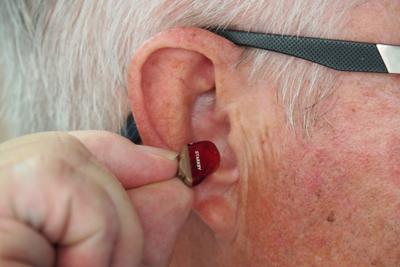
Hearing aids have come a long way. Gone are the days of the bulky over-the-ear aids that everyone can see. The newest models are practically invisible, and they work significantly better than the big bulky devices. You can experience the size and functionality of the latest hearing aids at your local hearing aid store.
The Earliest Hearing Aids
The first hearing devices were cumbersome and not very helpful. They were called ear trumpets, and people had to hold them up to their ears. These weren’t much more efficient than holding your hand up to your ear to try to direct the soundwaves into it. They didn’t do much to amplify the sound or to make it easier to hear in situations with background noise.
The First Electronic Hearing Aids
In the late 1800s, the first electronic hearing aids were available, but they weren’t popular. People still chose the ear trumpets, because the electronic hearing aids needed to be toted around in a large carrying case.
The carbon microphones were used until the 1920s when the first electronic vacuum-tube hearing aids were invented. These devices had two pieces, one you would carry in your pocket and a second that would fit into your ear. The two-piece hearing aids were the only option for 30 years, until the one-piece models arrived in the 1950s.
Modern Era Hearing Aids
In the 1950s, hearing aids evolved into single pieces. The convenient devices relied on small transistors to amplify sound. They were still bulky, and they didn’t do much to help people hear in noisy situations with various degrees of background noise. They had one setting, which didn’t offer much for people with excessive or minimal hearing loss.
The newest hearing aids use digital technology for full customizability, and many resemble small earbuds. They can filter noise and adjust to a wide range of sounds. Some models have smart technology that lets the wearers connect to their TV, phone, or computer for added convenience.
Digital hearing devices can be customized for a range of hearing loss, and most models have settings for low levels of hearing loss. Some models are built especially for people with severe hearing loss, and there are many models for people somewhere in between.
The Smallest Hearing Aids
People with hearing loss want small, convenient, and functional hearing aids. Most of the newest models are practically invisible, as they fit snugly in the ear canal rather than sitting outside of the ear. All too often, only the wearer knows they have hearing aids.
One of the best selling hearing aids is a device with a small tube that connects a piece behind the ear to a receiver in the ear canal. People often hide the connector with their hair. Other popular styles fit in the ear or partially in the ear canal. Nearly all can be customized and adjusted to fit the wearer’s degree of hearing loss. They will filter, amplify, and process sounds so wearers can experience the sounds of the world around them.
Here are some other articles related to your search:
Navigating the Hearing Aid Decision: CIC vs. Premium OTC Alternatives
Tuning into Clarity: A Comprehensive Guide to Selecting the Perfect Hearing Aids


(0) comments
We welcome your comments
Log In
Post a comment as Guest
Keep it Clean. Please avoid obscene, vulgar, lewd, racist or sexually-oriented language.
PLEASE TURN OFF YOUR CAPS LOCK.
Don't Threaten. Threats of harming another person will not be tolerated.
Be Truthful. Don't knowingly lie about anyone or anything.
Be Nice. No racism, sexism or any sort of -ism that is degrading to another person.
Be Proactive. Use the 'Report' link on each comment to let us know of abusive posts.
Share with Us. We'd love to hear eyewitness accounts, the history behind an article.